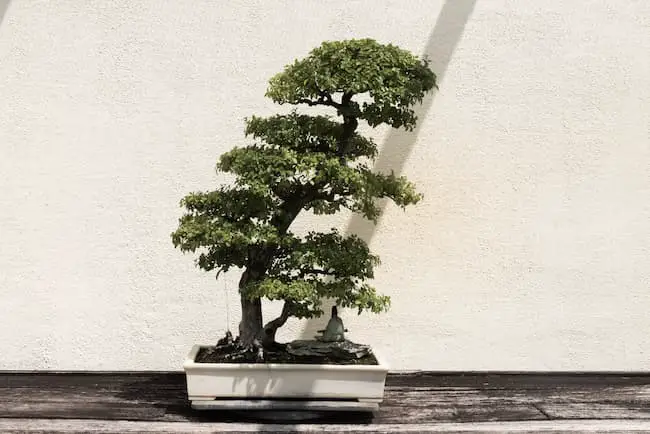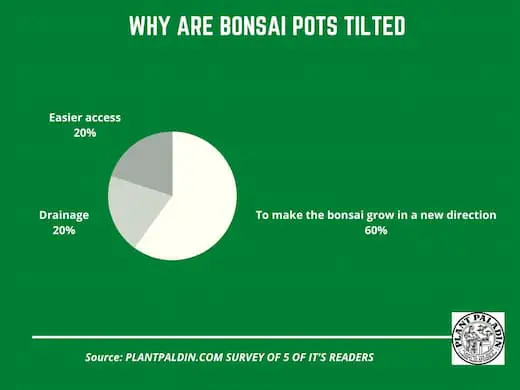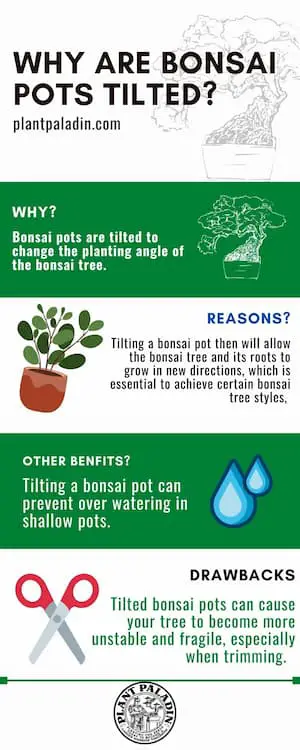This website is supported by its readers. If you click one of my links I may earn a commission. I am also a participant in the Amazon affiliates program and I will also earn a commission from qualified purchases.

One of the things that surprised me when I first started getting to grips with bonsai trees was how shallow the pots were compared to other flowers and plants I was used to growing. In the past few years, I’ve noticed an increase in tilting bonsai pots and keeping them slated to help grow trees. So why are bonsai pots tilted?
Bonsai pots are tilted to change the planting angle of the bonsai tree. Tilting a bonsai pot then will allow the bonsai tree and its roots to grow in new directions, essential to achieve certain bonsai tree styles, such as the slated style.
Tilted bonsai pots can also make it easier to prune and grow hard-to-reach areas obscured by natural branches or other elements.
So when should you tilt a bonsai pot? And do certain bonsai tree species work better in a tilted pot than others? Keep reading to find out more!
Just a quick heads up, over the past three years of running Plantpaladin, hundreds of people have asked for product recommendations. As such, You can find my favorite indoor bonsai tree here (link takes you to Bonsaiboy), my favorite outdoor bonsai tree (link takes you to Bonsaiboy), or have a look at all the products I recommend here.
Why are bonsai pots tilted?
I tested this with two of my bonsai trees to understand why bonsai pots are tilted.
I also contacted a few bonsai experts, visited my local botanical gardens, and surveyed five plant paladin readers who tilt their bonsai pots.
All to ensure you had the most in-depth post on why bonsai pots are tilted.
To summarize:
- Bonsai pots are tilted mainly to allow for better growth angles in your bonsai tree.
- If you tilt your bonsai pot by 30 to 45 degrees will cause the roots and branches to grow in a different direction.
- This can significantly help create movement in the tree or new styles, such as the slanting bonsai tree style, making the tree more aesthetically pleasing.
- Typically, tilting will be undertaken for 2 to 3 years, and then when reported, the new roots and branches will be growing in a new direction.
- Bonsai pot tilting can also help prune hard-to-reach areas of your tree that may be obscured or neglected because they are hard to reach when the pot is kept shallow.
- Tilting a bonsai tree pot can also be used to help improve drainage.
- Water will drain much faster in a tilted pot than in a shallow straight pot, which can pool water and lead to overwatering.
- For best results with tilting, consider a 30 to 45-degree tilt for pruning and training and a 20 to 30-degree tilt if you want to drain the pot faster.
When should you tilt a bonsai pot?
So now we know what tilting a bonsai pot is used for; when should you consider tilting your bonsai pot?
For me and the people I surveyed, these were some of the key reasons:
You want a more aesthetically pleasing bonsai tree.
If you are retired from the design of your existing bonsai and want to change the look, consider tilting your bonsai pot for a few years.
This will allow your roots, branches, and even trunk to grow in new directions that would be impossible if kept in an upright shallow pot.
This can then add bends and movement into your bonsai trunk and, if kept at extreme angles, allow your pot to achieve dramatic bonsai tree styles such as slanted or cascade bonsai styles.
As a good rule of thumb, I would take a walk to your nearby forest and observe trees, how they grow on hills and scale in natural slats, and try to mimic those designs.
Your potting soil is overwatered.
Another significant indicator it might be time to tilt your bonsai pot is if you have overly-wet bonsai soil.
Most bonsai tree species will only need to be watered once to twice per week when the potting soil is dry to the touch.
If your potting soil is constantly wet, this is cause for concern.
This can lead to severe overwatering and lead to problems like root rot.
To avoid this, consider leaving your pot at an angle that drains much easier than in a flat pot.
You need help pruning your tree.
During the spring and summer, most of us will start work on training and pruning our bonsai trees.
However, one major problem I have had in my few years of growing bonsai has been trimming hard-to-reach areas of my tree.
Even if using a bonsai turntable, this can sometimes be a chore and even make you regret starting the hobby in the first place!
Try growing your bonsai pot at a tilted angle for one growing season in this scenario.
This helped me to trim these more problematic areas and can be a massive benefit.
What is the best angle to tilt your bonsai pot?
The best angle to tilt your bonsai tree pot is between 30 to 45 degrees; this will allow your tree to grow at a new planting angle and achieve a directional change in root and tree growth. An angle of 20 degrees will typically be enough if tilting your pot for water drainage.
Benefits of tilting bonsai pots
Tilting a bonsai pot can offer several benefits, both aesthetic and horticultural. Here are some of the advantages of tilting a bonsai pot:
Visual appeal
Tilting the pot adds a sense of movement, asymmetry, and naturalness to the bonsai. It creates a more dynamic and exciting composition, visually captivating and engaging the tree.
Mimicking natural conditions
In nature, trees often grow on slopes or face environmental factors like wind or water flow, which can cause them to lean. By tilting the bonsai pot, you can simulate these natural conditions and create a more realistic and captivating representation of a tree in the wild.
Conveying age and character
Tilting the pot can give the impression of an older and weathered tree that has endured environmental influences over time. It adds character and tells a story of the bonsai’s journey.
Improved light exposure
Tilting the pot can help optimize light exposure for the bonsai. By tilting the tree towards or away from the light source, you can ensure that all parts of the tree receive adequate sunlight, promoting balanced growth.
Enhanced trunk movement
Tilting the pot in a particular direction can encourage the bonsai’s trunk to develop a more pronounced curve or bend. This can add visual interest and create a more captivating focal point in the design.
Better root development
Tilting the pot can influence the direction of root growth. The roots will tend to grow more firmly on the lower side of the pot, promoting a well-distributed root system.
What are the drawbacks of tilting bonsai pots?
While tilting a bonsai pot can have a lot of benefits, there are also potential disadvantages to consider. These include:
Unbalanced growth
Tilting the pot can affect the distribution of nutrients and water within the tree. The side of the tree facing upward may receive more resources, leading to uneven growth and potentially weakening the overall structure of the bonsai.
Challenging maintenance
Tilting the pot can make specific maintenance tasks more difficult. For example, watering the tree may become trickier as water can flow differently through the soil. Pruning and wiring branches may also be more challenging due to the altered orientation of the tree.
Limited tree species suitability
Not all tree species are suitable for tilting. Some species may not respond well to the change in orientation and may suffer from stress or decline. Researching and understanding your bonsai tree’s specific needs and tolerances is essential before deciding to tilt the pot.
Stability concerns
Tilting the pot can affect the stability of the bonsai. A significant tilt may make the tree more prone to toppling over, especially if the root system is not adequately anchored. Ensuring proper stability and secure tree anchoring becomes crucial when tilting the pot.
Challenging aesthetics
While tilting the pot can create a visually appealing composition, it may only sometimes be suitable or desirable for specific bonsai designs. Some bonsai styles, such as formal upright or literati, typically require an upright and vertical trunk without tilting.
Inconsistent watering and drainage
Tilting the pot can affect how the bonsai absorbs and drains water. It may lead to uneven water distribution or adequate drainage if carefully managed. Monitoring moisture levels and adjusting watering practices becomes more critical with a tilted pot.
Plant species that work best for tilting in a bonsai pot?
Several bonsai species work well in a tilted pot, as they can naturally exhibit characteristics that complement the tilted aesthetic. Here are some bonsai species that are often used and can thrive in a tilted pot:
Juniper (Juniperus spp.)
Many juniper varieties have flexible branches and can be styled with dramatic bends and curves. They respond well to tilting and can create a beautiful representation of windswept or cascading trees.
Pine (Pinus spp.)
Certain pine species, such as Japanese black pine (Pinus thunbergii) or Scots pine (Pinus sylvestris), can be trained in a tilted pot. They have rugged and gnarled bark, which enhances the aged appearance when combined with the tilt.
Spruce (Picea spp.)
Some spruce species, like the dwarf Alberta spruce (Picea glauca var. albertiana), can be tilted to achieve a windswept or mountainous effect. They have compact foliage and a characteristic conical shape that can be accentuated with the tilt.
Japanese maple (Acer palmatum)
Japanese maple bonsai are famous for their vibrant foliage and elegant appearance. They can be styled in a tilted pot, and their delicate, lacy leaves create a striking contrast against the tilted trunk.
Cascading or semi-cascading varieties
Species like the cascading forms of Chinese elm (Ulmus parvifolia), dwarf jade (Portulacaria afra), or waterfall-style Japanese wisteria (Wisteria floribunda) lend themselves well to tilting. Their cascading growth habit naturally complements the tilted pot.
Bald cypress (Taxodium distichum)
Bald cypress bonsai can be tilted to evoke a sense of trees growing near water bodies or in swampy environments. They have unique trunk characteristics and can develop exciting knee roots when tilted.
Remember that these are just a few examples; many other species can be suitable for a tilted pot.
It’s essential to consider each species’ growth habits, branch flexibility, and aesthetic characteristics to determine their compatibility with a tilted design. Additionally, ensure you provide proper care, including appropriate watering, light, and soil conditions, to maintain the health and vigor of the bonsai.
Slating tyle and tilting bonsai
Now one of the most prominent bonsai styles that people opt for when it comes to tilted pots is the slanted style.
Slated trees are hit by severe winds for decades, which case the tree to grow at an angle.
Using a tilted pot can achieve the same results.
To do so, grow your bonsai tree in a regular flat pot until it reaches maturity.
Depending on when your tree matures, this can take 5 to 10 years.
They report into a new pot but place the tree at an angle.
Place the pot at an angle to further exaggerate the slant.
Bonsai grown in flat pots?
Bonsai trees are typically grown in shallow pots to restrict the growth of the roots and the tree. This allows them to create the miniature look that bonsai trees have. Shallow pots are also unobstructed, causing minor damage to the tree.
What is the rule for bonsai pots?
The general rule for bonsai pots is that they should be the same height as the trunk’s circumference where it meets the soil. Typically, bonsai tree pots are about 2/3rds the total height of the bonsai tree.
What is the best shape for bonsai pots?
Traditionally, rectangular and square-shaped shallow bonsai pots are best for masculine bonsai trees. Round and oval shallow bonsai pots are best for feminine bonsai trees.
Why are bonsai pots tilted – survey results
I asked five plant paladin readers why some bonsai pots are tilted.
Here are their responses:

My top picks for the gear you will need!
So like I mentioned earlier, over the past three years of running PlantPaladin, hundreds of people have asked me for my recommendations on the best bonsai gear on the market.
Having spent thousands of dollars on bonsai items these past few years and tested at least 100 bonsai-specific products, I’ve listed my favorite products below – All of which I highly recommend and think you can get great value.
They can purchase directly by clicking the link to take them to Amazon.
Bonsai Tool Set: One of the significant challenges I’ve had is finding a toolset that was not only durable but didn’t break the bank. SOLIGT has recently developed a fantastic bonsai tool set that covers all the tools you need to trim, prune, and repot your trees. – You can grab it here.
Complete Bonsai Set: Many of you will want to grow your bonsai trees entirely from scratch, but finding the varicose seeds, pots, and other items in one place can be challenging. Leaves and Sole then have created a complete bonsai set that I’ve personally used that ticks all the boxes. You can grab it here.
Bonsai wire: The number of times I’ve run out of wire for my bonsai or purchased cheap bonsai wire that doesn’t do the job is embarrassing for me to admit. After a lot of trial and error, I found that using Hotop’s aluminum bonsai wire is one of the best options on the market. This can easily be used for both indoor and outdoor bonsai. You can grab it here.
This post was written by Fehed Nicass, who has been passionate about bonsai and gardening for over three years.

